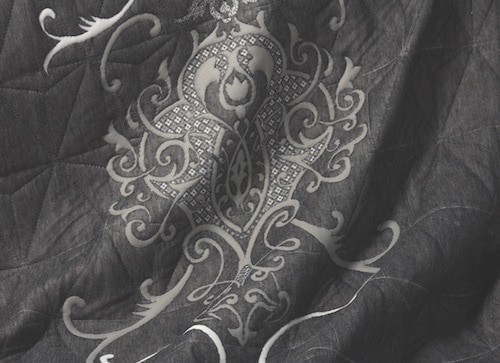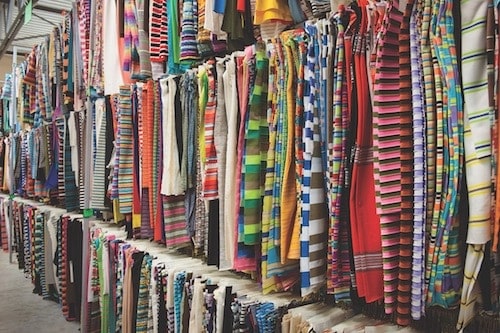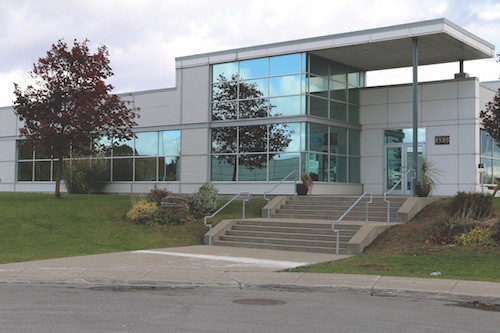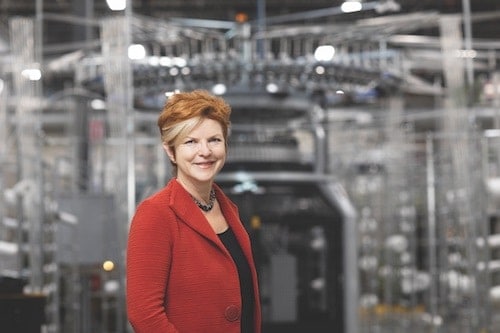BY GARY JAMES
Fabric supplier Tricots Liesse builds on expertise gained in years of creating knits for apparel
Tricots Liesse may be a relatively new name in mattress ticking, but in the world of luxury sportswear and swimwear, the Montreal-based producer has a well-established global reputation for creating innovative, on-trend stretch knit fabrics.
Founded in 1965, Tricots Liesse started with a 10,000-square-foot plant in the Liesse district of Montreal, producing circular single-knit fabrics for apparel. The company grew steadily and, in the early 1970s, added circular knits to its line.
In 1998, sensing an opportunity to expand its footprint, Tricots Liesse built a 250,000-square-foot facility, also in Montreal, to house a state-of-the-art finishing and dyeing operation, known as Di-Tech. Roughly half of the plant’s space is devoted to knit fabric production; the other section is dedicated to Di-Tech.
In addition to its vertically integrated facilities in Montreal, Tricots Liesse has sales offices in Los Angeles and New York and a warehouse in High Point, North Carolina, which soon will carry ticking and other fabrics for mattress manufacturers, along with its current assortment of apparel fabrics, for quick shipment to customers. In apparel, Tricots Liesse serves a “who’s who” of leading swimwear and sportswear brands, including Eileen Fisher, Perry Ellis Swimwear, Poprageous, Nautica Swimwear, Helmut Lang, Alice + Olivia and Elie Tahari.
The company’s Montreal facility boasts more than 200 employees and 135 knitting machines producing a diverse array of knits and fleece, including intricate jacquards, blisters and quilts. The equipment — most of which is sourced from Germany and Italy — includes double-knit rib, double-knit interlock, automatic stripers, single-knit and double-knit electronic stripers, single-knit minijacquard, single-knit terry, open-width jersey and polar fleece machines. All the machines are housed in separate containment rooms to maintain quality, and the entire facility is air conditioned to ensure materials used in production are stored in optimal conditions prior to manufacturing.
“When I first saw our plant, I couldn’t believe how amazing it looked,” says Camilla Franklin, who joined Tricots Liesse in the fall of 2017 as vice president of sales and marketing for its new bedding program. “It’s spotlessly clean, very organized and filled with all the latest equipment. The people at the factory also are fantastic — and everyone treats each other like family. It’s a tightly knit, well-oiled machine and everyone is focused on the mission of creating quality fabrics that meet our customers’ needs.”
Tricots Liesse hired Franklin to lead its entry into sleep products. A veteran design, sales and global sourcing executive, Franklin started her mattress career in 1996 with the former Blumenthal Print Works, where she was vice president of design and research and development. Most recently, she was design director for BekaertDeslee and, prior to that, she served in the same position with the former DesleeClama. In addition, Franklin has worked with AEC Narrow Fabrics and Lava, and consulted independently for bedding major Serta Simmons Bedding LLC and other mattress manufacturers.
“Textiles have always been my passion, even before specializing at college and in my post-graduate work in the United Kingdom,” Franklin says. “I am thrilled to work with Tricots Liesse and I can honestly say, having been in this industry for 21 years and having worked with mills both in the U.S. and abroad, (this company) brings a uniqueness to textile manufacturing that I have not seen before.”
Tricots Liesse’s success is built on design, innovation and putting the customer first, Franklin adds. “Ensuring on-time delivery and achieving a return rate under 0.4% for the past 15 years are two of our key competitive advantages,” she says.

Soft hand quality meets fashion-forward design in Tricots Liesse’s debut Mattress & Sleep Fabric line, which launched at ISPA EXPO 2018 in March.
Creating a line from scratch
During her first six months at Tricots Liesse, Franklin’s priority was working with a team of in-house designers to develop the company’s first offering of knit mattress fabrics. The line — which made its debut at ISPA EXPO 2018 in March — features a wide assortment of styles in the mid- to higher-end price range distinguished by quality construction, innovative use of color, and incorporation of advanced cooling and other technologies that enhance value and performance.
The line generated a “highly positive response,” according to Franklin, and the momentum the company gained at the show has continued to build as she and her new sales team have met with prospective customers in the United States (the company’s main market ) and in Canada.
“We’re feeling very good about the progress we’ve made in the past year,” Franklin says. “We have some good production orders placed that are ongoing and growing. We’re getting a lot of great feedback about the creativity of our designs — which are very fresh and different — and our fabric hand, which is very soft and luxurious. We’re drawing a consistently positive response to our presentations, as well as generating a number of ideas for unique new products that potential customers would like to see us do.”
Tricots Liesse’s designers use the latest computer-aided design tools to design fabrics to meet customers’ specific needs, Franklin says. In addition, the company steadily is expanding its assortment of its own designs, a strength for which it is well-known in the apparel community, according to Franklin. On the fashion side of its business, the company creates more than 2,000 new circular knit styles annually.
In addition, Tricots Liesse offers a variety of fabrics for industrial, military, law enforcement and other specialty uses. These fabrics are distinguished by fire resistance, electric-arc protection, high-visibility safety features and other protective or technical properties.
The success the company has had with its expansion into technical textiles laid the foundation for the move into sleep products fabrics, according to Franklin. “Some studies were commissioned that resulted in our diversification into new markets,” she says. “Prior to mattresses, the company moved into technical textiles for protective wear and that was very successful. They then decided to add the sleep division.”
While the Tricots Liesse “look” in ticking still is being defined — and will evolve as the market and customers’ needs change — “new and fresh are the key elements we want to always have associated with our line,” Franklin says. To create its designs, the company employs a team of six designers — all with deep experience in fashion and apparel. The group keeps a close eye on the latest trends in fabric construction, technology and design through its ongoing work with clients and biannual global trend-hunting excursions.
“Our designers are constantly on the lookout for new and different ideas for our fabrics,” Franklin says. “It’s important that we stay on top of all the latest developments in style, materials, structures and finishes. We are always pushing the envelope. Our design team visits London and Paris twice a year to trend hunt.”
Along with its pool of design talent, Tricots Liesse has a skilled group of chemists, textile engineers and other technical specialists on its team. Working collaboratively, these in-house experts enable the company to respond quickly to a wide range of customer needs, Franklin says.
“We are renowned for our ability to innovate and develop new products quickly and creatively,” she says. “We have a super design and technical department with associates from around the world. They are talented, creative and quick to respond, and have decades of experience.”

Franklin describes Tricots Liesse’s fabric archive as “an Aladdin’s cave of fascinating fabrics.” “I can spend an entire afternoon getting lost in inspiration,” she says.
The finishing touch
As in its apparel lines, where properties such as moisture wicking are critical for yoga and running gear, technology plays a big role in Tricots Liesse’s offerings for the bedding industry.
Performance finishes for ticking include Arctik, a dual coating of phase-change material applied to both sides of the fabric that enhances and extends temperature regulation and cooling; Restore, a topical treatment with microcapsules of Q10, a natural coenzyme that scientific research shows has antioxidant and other skin regeneration benefits; and Serene, a collection produced with super-conductive, Q10-infused yarn that is cool to the touch with an extra-soft feel. In addition, Tricots Liesse offers fabrics with anti-microbial properties. The company’s ticking finishes are provided by a variety of leading suppliers, including Proneem, which makes Q10 technology.
“Our customers — and their consumers — are showing more and more interest in performance finishes of all types,” Franklin says. “It’s a reflection of the growing emphasis on health and the role that quality sleep plays in productivity and well-being. We see good sell-through in added-value products, and we expect this aspect of our fabrics to become even more important in the coming years.”
The fact that Tricots Liesse has its own finishing facility provides a key competitive edge in the creation of unique, high-tech fabrics, according to Franklin. And the same is true for the company’s certified dye lab, which employs the latest computerized software, machinery and dyes to create one-of-a-kind looks.
“We have one of the most modern and efficient dyeing and finishing facilities in North America,” Franklin says. “Our European-influenced Di-Tech facility has the unique ability to process everything from small runs to very large programs, including a multitude of different finishes, knit weights and wovens. Being a vertical operation also permits us to control deliveries and quality to a very high level and, as a result, the speed with which product is brought to market is impressive.”
Because it has its own on-site dyeing capabilities, Tricots Liesse is in a position to offer custom color borders and a wide range of other tailored color options. “We can match any color a customer needs, as well as develop unique colors quickly to match a specific Pantone chip or other specification,” Franklin says.
To meet its customers’ needs, Tricots Liesse maintains a large on-site yarn “bank,” too. The area, like the rest of its facilities, is air conditioned to ensure materials remain in top condition. As part of the launch of its new ticking line, the company has developed a number of new yarn colors specifically for use in bedding, and it keeps supplies of all best-sellers in stock for quick turnaround. New colors will be added continually to keep the line fresh.
“We have a couple of new colors from our fashion line — including some fresh heather blues and a mango tone — that we were excited to introduce in our bedding, and they’ve been very well-received,” Franklin says. “As we move forward, we’ll continue to look for hot colors from our fashion lines that could be a good fit for the mattress market.”
While the bedding industry is much less open to experimenting with color than apparel, where consumers always are looking to make a fashion statement, there seems to be a growing willingness to try new things, Franklin says. “Some of the production orders we’ve received have been on the brighter side, with more intense, modern colors used as accents. Buyers aren’t quite as conservative as they have been.”

Tricots Liesse is known as an industry innovation leader in sportswear and swimwear and has been producing luxury fabrics since 1965. It now has added state-of-the-art knitting machines for the mattress market.
Testing, one, two, three
To ensure that its products meet the stringent quality demands of customers, Tricots Liesse operates a state-of-the-art testing laboratory, where textile graduate technicians follow AATCC and ASTM regulations. The company conducts color fastness tests, wet and dry crock tests for bleeding, Martindale tests for abrasion, random tumble tests for pilling, Mullen burst tests for pressure control, Instron testing for stretch, plus many more, according to Franklin. The company also works with an outside lab to do anti-microbial tests. Testing for the apparel industry is particularly demanding, Franklin says, and the company’s mindset of rigorous quality assurance is now being applied to its ticking and other bedding-related fabrics.
“Nothing ships from our factory until it passes the specific performance criteria of our customers,” she says. “For the swimwear industry, which is very stringent with its testing, fabrics have to be able to withstand harsh elements such as salt and chlorine water, bright sun and hot car trunks. The colors have to have a perfect consistency without any bleeding or crocking at all.”
Some of the company’s products also meet Oeko-Tex’s Standard 100, an independent testing and certification system that verifies textiles are free of harmful substances and contaminants.
“Consumers want to know what’s in their products today,” Franklin says. “They have a lot of concerns, particularly with so many beds coming in from China. Having our products go through Oeko-Tex certification provides additional peace of mind about what they are buying.”
Tricots Liesse also requires that its yarn sources and other suppliers provide similar quality and origin assurances about the materials they provide. “We require inspection and traceability for our yarns at every level of the supply chain,” Franklin says. “We want to know exactly what’s happened to everything we use. And once materials arrive at our plant, everything is carefully checked and analyzed to make sure it’s up to our standards.”
Bedding fabrics, while not subject to all the environmental extremes experienced by swimwear, still have to hold up in a range of challenging situations. Fabrics used on boxed beds, for example, may be subject to very hot temperatures during shipping, and compressing and rolling mattresses also can cause issues.
“Once your bed pops out of the box, you don’t want a bunch of wrinkles on it,” Franklin says. “There are certain yarns, particularly in the woven arena, that will not perform at all and should not be used. Quality knits like ours definitely have an edge in this type of application.”
Tricots Liesse already has signed on one major boxed-bed producer, and it currently is talking to several companies about how its fabrics might be used for their step-up lines, Franklin says. “This segment is getting very crowded, so companies are looking to set themselves apart,” she says. “Enhancing the look and feel of ticking is one great way to do that.”
Franklin also sees exciting opportunities for the company in the pillow arena. “Some of the fabrics we make for performance activewear could have a nice crossover into the pillow area,” she says. “There’s a lot of technology inside today’s pillows, so it makes sense to use a fine fabric made of luxury or performance fibers and yarns with a soft hand that can stretch with the foam and enable it to breathe and function to its fullest ability.”

Tricots Liesse is headquartered in Montreal where it has a 250,000-square-foot facility that includes knit fabric production, plus a finishing and dyeing operation called Di-Tech.
Thinking green
Throughout its operations, Tricots Liesse strives to be energy efficient and practice sustainability. The Di-Tech facility, for example, has reduced its energy consumption by employing heat recovery systems for waste water and steam. Use of a continuous scouring system in the textile finishing process has reduced water consumption.
“One of our company core values is sustainability,” Franklin says. “We built our plant with this in mind and continually monitor air and water quality. The result is a great working environment, as well as good quality product with close to zero contaminants, which is very unusual in the mattress fabric market.”
In addition, the company recycles many of the products it uses, both internally and through programs with customers.
“We will continue to be environmentally conscious and do our part where we can to not impact the environment in a negative way,” Franklin says. “We are constantly looking for new energy conservation systems to maintain our status as the most ecologically minded dye house in North America.”
As Tricots Liesse heads into the second year of its mattress ticking program, the company will be looking for new ways to generate awareness and reach potential customers. Its newly formed team of four independent sales representatives will be an integral part of that process, and so will the company’s website, which recently has been updated to reflect the launch of the new ticking program.
“We’re not well-known among bed producers yet, so it’s a challenge to get our name out there,” Franklin says. “Having a well-designed website that reflects our identity and our key strengths is an important first step. With all our communications, we are emphasizing two key themes: Our customers always come first, and our mission is to provide them with consistently high-quality, innovative products.” •






